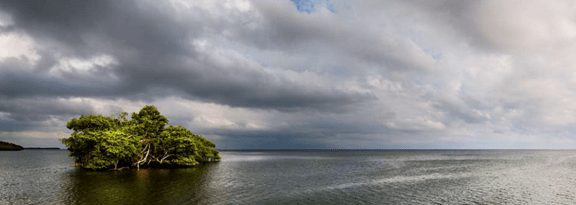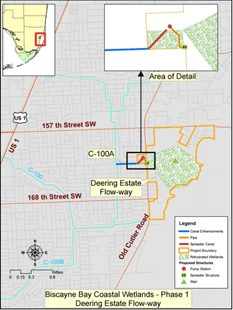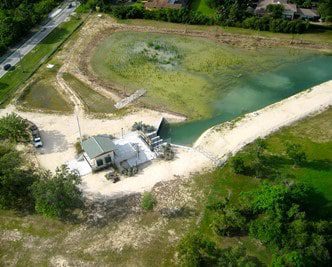|
Getting your Trinity Audio player ready...
|

Spanning nearly the entire length of Miami-Dade County, and serving as home to over 500 species of fish, birds and other marine organisms, sits the Biscayne Bay Coastal Wetlands. While this diverse ecosystem filled with mangrove forests, vast areas of seagrass, and colorful off-shore reefs appears a stunning site for the visitor’s eye, within, this coastal community is facing the ever-growing effects of climate change.

In order to shine a light on the vital role wetlands play in our local community, The Deering Estate hosted their first ever “Biennial Deering Symposium” on February 2nd- 3rd, virtually joining individuals from around Miami Dade County to celebrate World Wetlands Day. This day of global awareness included presentations by Miami-Dade Parks, Recreation and Open Spaces, South Florida Water Management District, Fairchild Tropical Botanic Garden and Florida International University. Discussions took place on topics such as fungi of South Florida, detecting and identifying water constituents, and the archaeology of the Deering Estate, with emphasis on topics pertaining to the restoration of Biscayne Bay Coastal Wetlands (BBCW) and the Deering Estate Rehydration Project.
The Biscayne Bay Coastal Wetlands Project is an ongoing restoration with the purpose of diverting water flow into the bay, rehydrating saltwater and freshwater wetlands, as well as providing vital resources to estuarine habitats along the coast. Appropriate salinity levels need to be maintained for species and ecosystem functions to survive. If water, nutrient and salinity levels are not monitored and maintained during the wet season, this can become a stressful environment for the flora and fauna living in these estuarine and coastal areas.
Dallas Hazelton, Project Supervisor and GIS Coordinator for Natural Areas Management of the Miami-Dade County Parks, Recreation and Open Spaces Department, was one of the speakers at Deering’s Symposium. He went in-depth on his presentation about the comprehensive part of the Biscayne Bay Costal Wetlands project – the Deering Estate Flow-way/ Cutler Slough Rehydration project. Engineers and biologists from the South Florida Water Management District partnered to conduct and oversee this project. Hazelton went on to explain the steps of the wetland rehydration. This included the installation of a pump station just west of Old Cutler and a weir placed in Cutler Creek which prevents saltwater intrusion. The goal of this project was to help restore seasonal water flow into the freshwater wetland habitat that once was, before local canal systems were built. In fact, since the 2013 completion of the Deering Estate Flow-way, more than 62,000 acres per feet of freshwater have been redirected into the historic wetlands.
The Deering Estate Flow-way provides not only a change in water direction, but also alters surrounding habitats, calling for a need in regular monitoring of soil, water, wildlife, and vegetation in the area. In order to learn more about ongoing conservation and monitoring efforts taking place, I spoke with the South Florida Conservation Program Manager at Fairchild Tropical Botanic Garden, and a speaker at Deering’s Symposium, Jennifer Possley. Since 2002, Jennifer Possley and her team have been monitoring and reintroducing rare plants into areas of the Deering Estate, working in slough plots placed along the Cutler Canal. As to her research and the recent studied trends seen in vegetation growth near the Cutler Creek area, Possley says “While there have not been very dramatic trends across the board, in wetland (slough) plots there has been a trend whereby upland/ hammock vegetation is gradually being replaced by wetland vegetation like willows, graminoids.” When asked about an overall positive outcome she has seen in this Rehydration Project, she stated, “ I think the most positive change for the upland vegetation that we study is that it is shifting to more closely resemble what it must have been like before modern people came in and completely altered the hydrology. That is to say that low-lying (slough) areas are shifting away from hammock vegetation and toward freshwater wetland, while upland (hammock) areas are remaining relatively unchanged.”
The work does not stop here, though. With our coastal wetlands and Biscayne Bay facing constant environmental threats and changes, further research, scientific restoration and documentation of these impacts must take place. Efforts to enhance Biscayne Bay’s health will not only prove beneficial for coastal wetland vegetation and organisms, but will build resilience, showing positive ramifications such as increased protection against storm surge and sea level rise, and provide reliable drinking water for our community.
Danielle Zamanillo is a recent graduate of Florida State University with a bachelor’s degree in Psychology. She is currently an intern at the Deering Estate.







